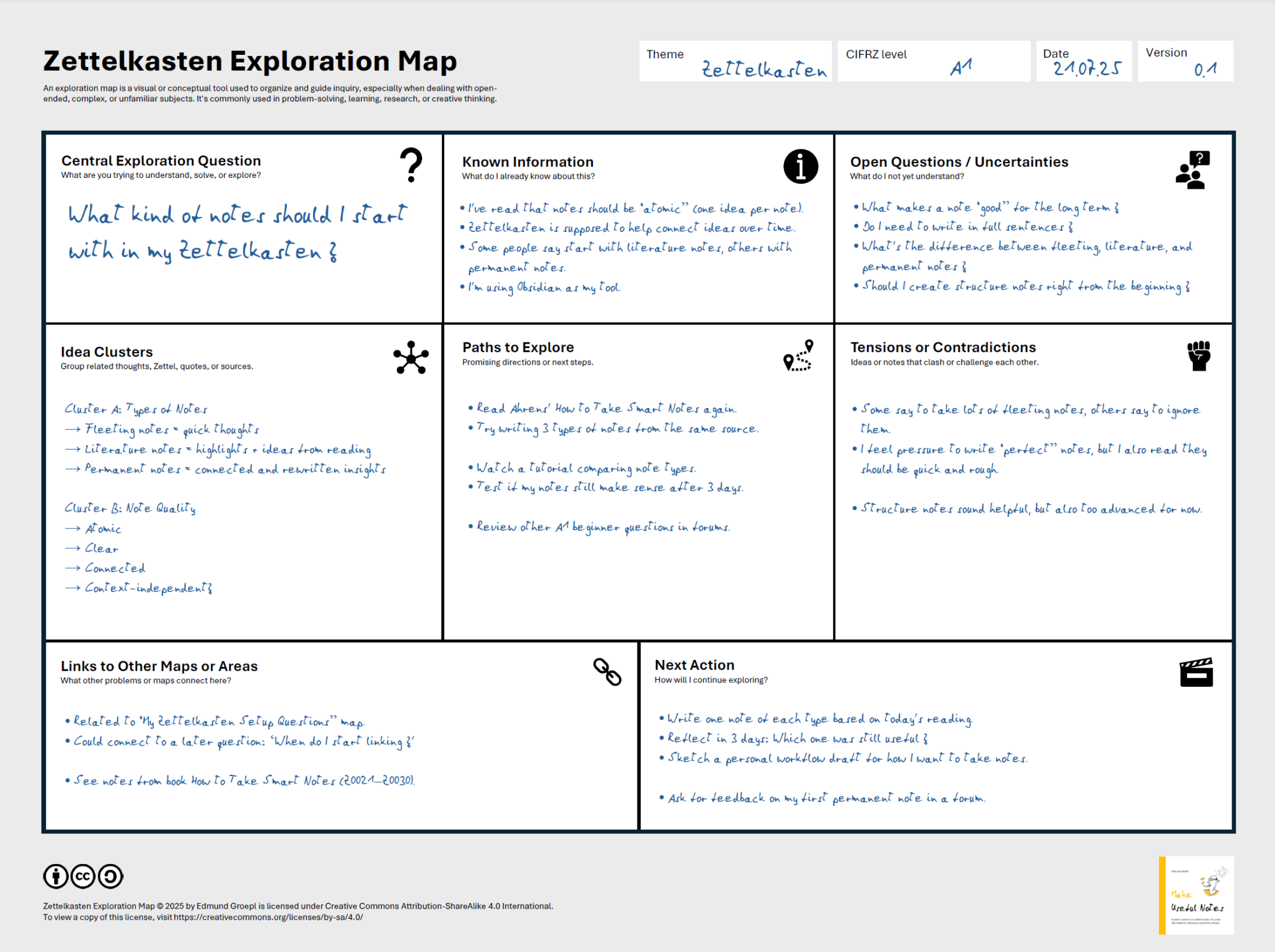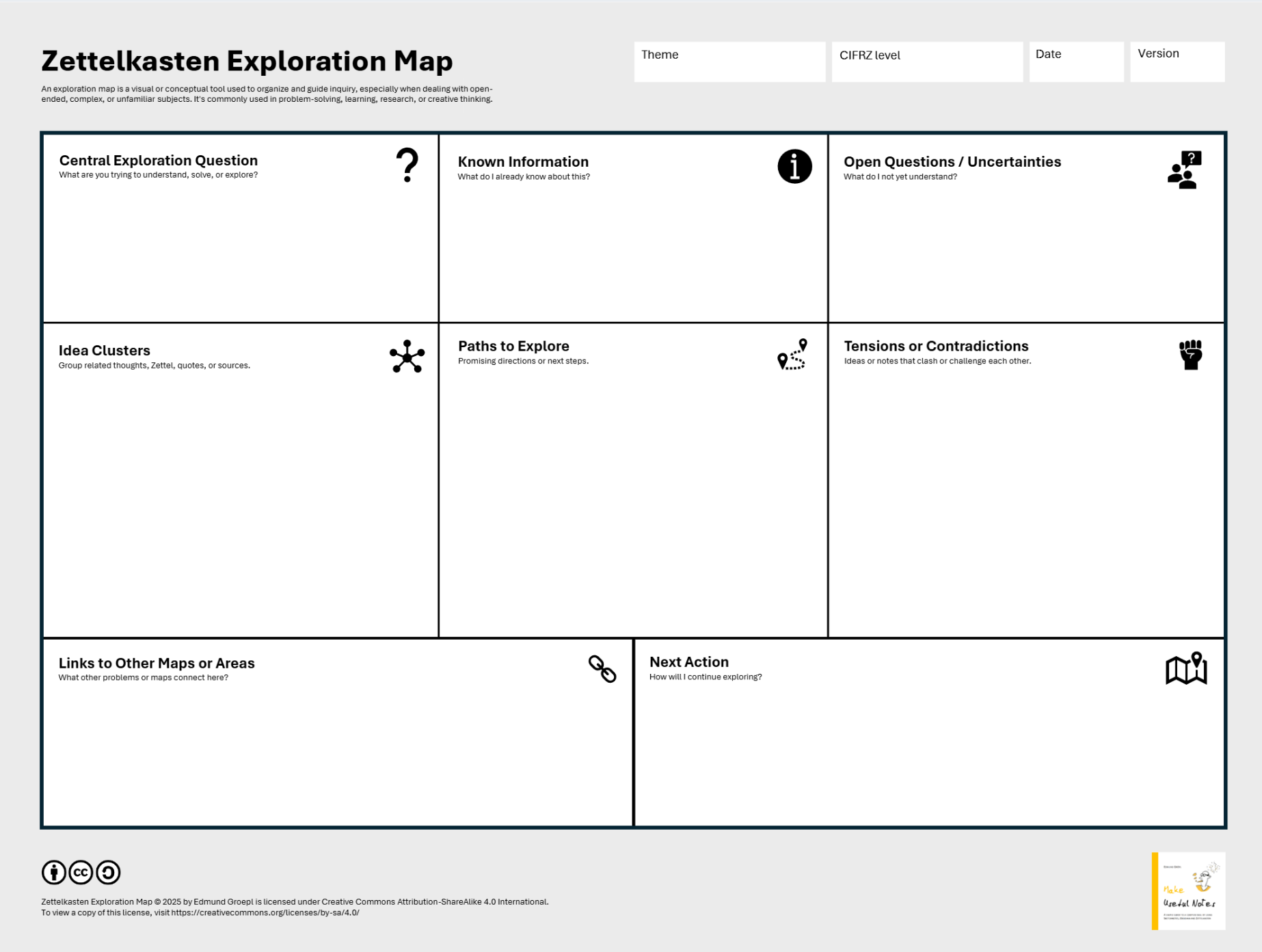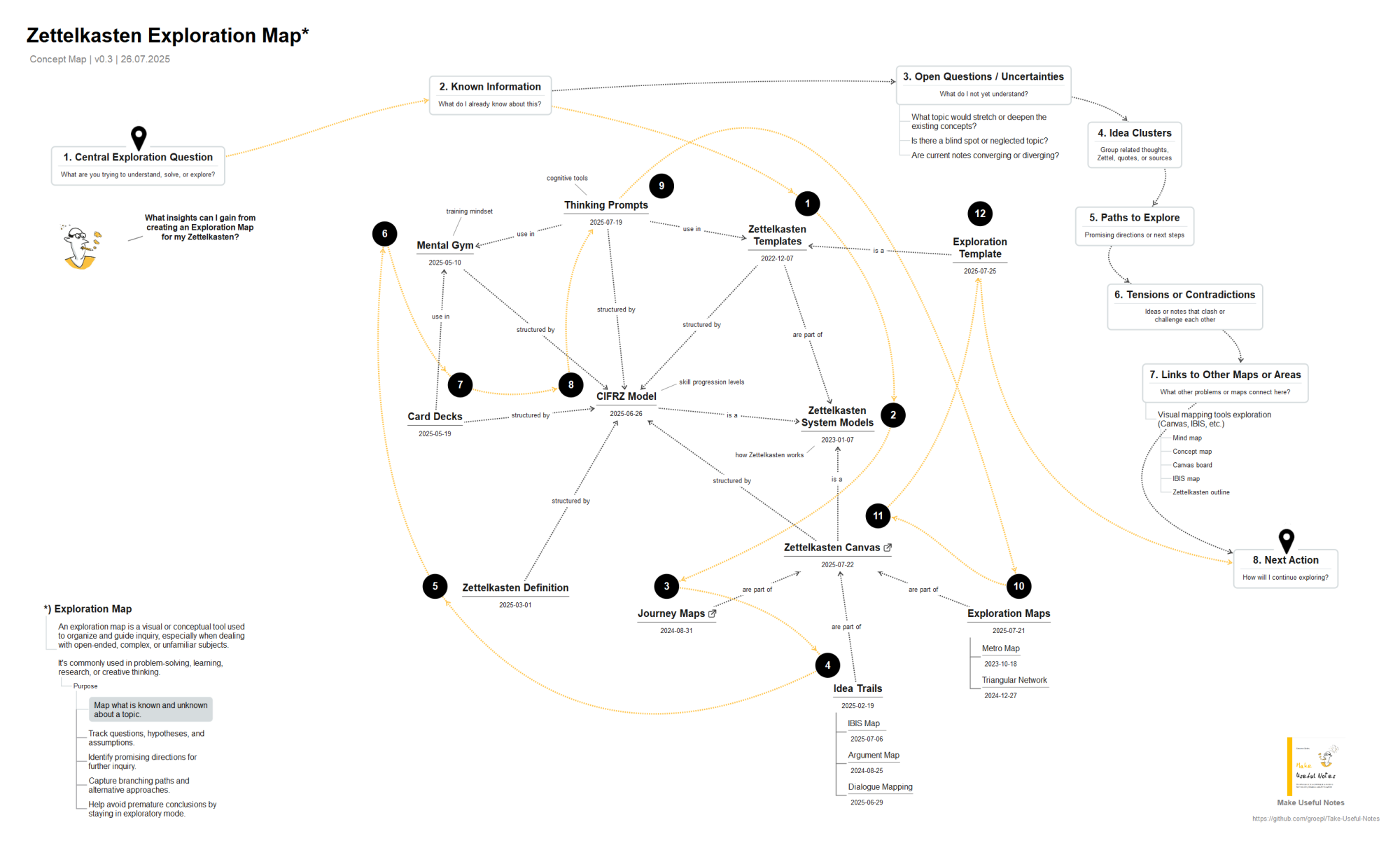Zettelkasten Exploration Maps
In Zettelkasten, we often ask: “What does this note connect to?” But a better question might be: "What am I currently exploring?” Exploration maps shift the focus—from collecting to inquiring.
A short definition: An exploration map is a visual or conceptual tool [1] used to organize and guide inquiry, especially when dealing with open-ended, complex, or unfamiliar subjects. It's commonly used in problem-solving, learning, research, or creative thinking.
Here is an example:

It's based on a template, which makes it easy to start with:

One more example: https://forum.zettelkasten.de/discussion/comment/23523/#Comment_23523
References
[1] Clark, Tim, Alexander Osterwalder, and Yves Pigneur. Business Model You: A One-Page Method for Reinventing Your Career. Wiley, 2012.
Edmund Gröpl — 100% organic thinking. Less than 5% AI-generated ideas.
Howdy, Stranger!

Comments
@Edmund Thanks for posting this useful chart! I can see myself working through it in the future, on a few issues!
The design of the graphic above is based on the graphic design of Strategyzer's business model canvas, I note for those who are unfamiliar with it.
If you're using such a template on your own, you can arrange the elements of the template in any way you wish. You may as well simply write the information in a plain-text outline so that you have searchable text instead of unsearchable text in a raster graphic like the one above.
I haven't heard the term exploration map before, and a quick search in typical reference sources doesn't uncover any reliable sources about it, so I don't know whether @Edmund invented that term or borrowed it from elsewhere.
Are you using Linux? Because in a decent Unix system, like macOS for instance, text in an image is selectable and thus searchable. If you use Linux you could install what is needed to get that functionality.
As you've seen, the masses on at least two of the three relevant platforms, take this functionality for granted and probably think that's how things are.
Yes, it‘s not a Zettelkasten term. I borrowed it from Design Thinking. For me it describes perfectly it‘s function in the described process.
I also use a Zettelkasten Exploration Map template in markdown with Obsidian. The visual I choose is more for presentation purposes.
Edmund Gröpl — 100% organic thinking. Less than 5% AI-generated ideas.
@Perikles said:
I use both macOS and Linux, but the versions I use do not allow searching for text in raster graphics. Googling it now, I see this is reported to be a feature in more recent versions of macOS. I guess you could store your entire note system as raster graphics now! Congratulations, and have fun with that, but no thanks: I'll keep using non-raster-graphics formats for my searchable text.
Sorry for the raster graphic. Here's a link to a PDF version: https://github.com/groepl/Obsidian-Templates/blob/main/Assets/Zettelkasten-Exploration-Map_2025-07-21.pdf
Edmund Gröpl — 100% organic thinking. Less than 5% AI-generated ideas.
@Edmund said:
Thanks for the PDF. It's great! There is no need to apologize; I see that it may have sounded as if I was complaining about the raster graphic, but I was just trying to point out the (perhaps obvious) option of storing this kind of information as plain text in your note system. It seems to me that the graphic template with the boxes is most useful when you are writing by hand on the template, as in a live workshop situation.
Yes, that's right. You can also use sticky notes and write by hand, moving them around the template as you wish.
Today, I experimented with an Exploration Map that I had created using SimpleMind:

I started with some of my latest key terms from Zettelkasten. For context, it is designed as a concept map with linking words (dashed black). I also added a timeline based on the creation date of my first notes connected to these key terms. The yellow line shows my thought process (idea trail), starting with '1 - Zettelkasten Templates' and ending with '12 - Exploration Template'.
But it's only a draft. It will require further exploration.
Edmund Gröpl — 100% organic thinking. Less than 5% AI-generated ideas.
When I'm stuck in exploring the details of an idea, it sometimes helps to view the system of ideas from a bird's-eye view:
Each type of note never shows an isolated idea or concept.
Edmund Gröpl — 100% organic thinking. Less than 5% AI-generated ideas.
Sometimes, making things more complicated is the first step towards making them simpler. The added colors are showing the transition between different themes on a higher level:
Now the Exploration Map it can be reduced to:
It is now clear that changing the order of thinking (training, learning, development) was necessary to improve my initial set of Zettelkasten templates.
Edmund Gröpl — 100% organic thinking. Less than 5% AI-generated ideas.
An Exploration Map:
Reference
When was the last time you did something for the first time? — John C. Maxwell
Edmund Gröpl — 100% organic thinking. Less than 5% AI-generated ideas.
An Exploration Map:
This is the most comprehensive visual representation of my Zettelkasten system yet. It illustrates the themes and insights from the last four years. A long journey now leads to a single sentence:
Edmund Gröpl — 100% organic thinking. Less than 5% AI-generated ideas.
Very, very nice.
In my process I can recognize some fragments of this model, not so explicitly structured and represented.
Today simply a bunch of "default questions" that I've internalized with practice of writing hundreds of notes.
These types of tools significantly help prevent blank-page syndrome and allow you to develop an idea in a very comprehensive and consistent way.
two enormous benefits.
However, I always have the fear that that they become a too rigid cage.
Often, too often the best ideas emerge by thinking beyond the predefined boxes of these types of templates. Something that you wouldn't know where to place there once it emerged, and that wouldn't come out if you always thought only in predefined directions.
I trade a bit of systematic thinking for the chance to be creative, or at least to think outside the box. It's a delicate balance to pursue.
Another issue, for me, having too many boxes to fill It generates anxiety to fill them, and the effort to fill them exhausts the available cognitive energy :-)
I think, in the end, that such kind of tools are good for initial practice (something like a training), but that after having practiced with them it's better to have a blank sheet and use what the practice has left in your mind as internalization.
And I think that the templates itself have to been periodically changed, in this way the mind trains itself to the most varied stimuli and does not risk becoming too mechanical.
It's not your case, you propose a nice model every week or two :-))
Just my two cents — not a critique of your model (which I find excellent), but a broader reflection on templates, frameworks, and idea development tools. Reflections about a better use of them, maybe.
Thank you @andang76 for your comments. Here are my comments on your comments. ;-)
I enjoy making hidden structures visible.
For me, thinking becomes easier.
Yes, it's a cage. It's a cage that I designed myself. I can change it whenever I want. There are an unlimited number of different cages. But I have to find a good one. One that aligns with my thinking.
There are no boxes to fill in. The idea comes first, then the creation of the box. Without an idea, a box is invisible. As with mind mapping, however, there is always an opportunity to add a new idea to the canvas.
Yes, I prefer to use paper and pencil. However, these sketchnotes are for personal use only.
"Reflection on templates, frameworks, and idea development tools." - A great idea. Thank you for sharing.
Edmund Gröpl — 100% organic thinking. Less than 5% AI-generated ideas.
Did you ever explore your Sources of Meaning [1]? Your existing Zettelkasten may help you. Here's my exploration map:
Reference
[1] Schnell, Tatjana. The Psychology of Meaning in Life: Insights and Applications, Second Edition. Taylor & Francis, 2025.
Edmund Gröpl — 100% organic thinking. Less than 5% AI-generated ideas.
@Edmund said:
Interesting: I have done Ford & Nichols's Assessment of Personal Goals (APG) using their asssessment web app every few years since 2010 and found it helpful for self-reflection.
I first heard about Schnell's Sources of Meaning and Meaning in Life Questionnaire (SoMe) around the same time as I first heard about the APG, but I forgot about the SoMe and never noticed the similarity to the APG. Now that I look at and compare both assessments, the 24 items (goals) of the APG seem to serve an essentially equivalent purpose as the 26 items (sources of meaning) of the SoMe.
In Schnell's Hierarchic Meaning Model (HMM), "sources of meaning" are superordinate to goals, but she implies that "higher-level goals" (as in the APG) are equivalent to "sources of meaning": "Actions are experienced as meaningful when they serve superordinate [higher-level] goals."
So, yes, I regularly explore my "sources of meaning" but using the name (higher-level) "goals".
Thank you for this link. I have now completed the "Assessment of Personal Goals" by Ford & Nichols for the first time, and the results were somewhat surprising. 'Creativity' was ranked as 'sometimes motivating', with a score of 25. 'Physical Well-Being' was on top with 39.
And I've got some great insights I'll use for reflection:
Edmund Gröpl — 100% organic thinking. Less than 5% AI-generated ideas.
@Edmund said:
Yes, it's similar for me, although my creativity scores were higher, the highest scores are often the most mundane goals. It turns out that we really like eating and having shelter and being healthy...
Thanks for sharing. I completed the assessment and my top score was creativity at 39 and physical well-being came in at 26. Both of these scores seem pretty consistent with previous testing I have done over the years.
Amazing – just the other way around! Have you also discovered your Goal-Life Alignment? I spend most of my time for 'Physical Well-Being'. Is it the same with your 'Creativity'?
Edmund Gröpl — 100% organic thinking. Less than 5% AI-generated ideas.
Today I wanted to see my Exploration Maps in a broader context:
However, this is a high-level view that may require an example for better comprehension.
Let me start by applying the AIDA marketing method to my Zettelkasten practice. It's a sketchnote that shapes the visual inspiration:
We just see the basic elements of the AIDA method. To find out more about the relation to Zettelkasten, we need to zoom in and explore the underlying concepts and connections:
The Exploration Map answers many questions that the sketchnote did not, making it a valuable resource for seeking more in-depth insights or wanting to use it to facilitate discussion with others.
One note is missing from my Zettelkasten. It's a zoomed-out version with links to the most relevant notes on which the concept is based:
It's a Map of Content and easy to remember. Here's the full story:
The AIDA model—Attention, Interest, Desire, Action—is a classic framework in marketing. It maps how a person moves from first noticing a product to finally acting on the urge to buy it.
But the same process happens inside our minds when working with a Zettelkasten.
More about at: https://forum.zettelkasten.de/discussion/2394/how-to-use-creative-techniques-within-the-zettelkasten-framework
Edmund Gröpl — 100% organic thinking. Less than 5% AI-generated ideas.
This looks awesome!
I am a Zettler
@Edmund Thanks for this post about AIDA - it captures a process that we experience multiple times a day, yet I had never really thought about or recognized it. I'm still thinking about how it relates to writing zettels. There must be an additional element in there about "staying power" - is the idea sufficiently enticing that we pursue writing one or several zettels to a mature state?
And for our Zettelkasten overall, we need some driving purpose(s) to motivate our continued involvement in creating and growing it. Yes, growing our Zettelkasten has its inherent rewards. However, over the long term, I believe we need some higher level purpose to keep us going (at least, I do)
@sascha I really appreciate that! Have you tried something similar in your own workflow?
Edmund Gröpl — 100% organic thinking. Less than 5% AI-generated ideas.
It depends on what you mean by similar. I regularly create visuals and think visuals are a pretty powerful tool in the box. However, in my workflow I seem to be pretty unartistic.
I regularly create visuals and think visuals are a pretty powerful tool in the box. However, in my workflow I seem to be pretty unartistic. 
This is current:
And this is my visual approach to fantasy world-building:
So, I am not a producer of visual art AT ALL.
I am a Zettler
+1 to this! The powerful line work and contrast is really captivating. As a series, that'd be the most exciting, invigorating business poster series in the world
Author at Zettelkasten.de • https://christiantietze.de/
Yes, your visual works well! 👌
At first, the bubbles grab my attention. But what does 'ANS' stand for? My desire to learn more about training prompted me to take action: I asked Google.
Now I have some more Literature Notes about 'regulatory medicine' and 'hypoxic training' for a longer and healthier life. And I was not aware that "In 2019, the Nobel Prize in Medicine was awarded to the three scientists William Kaelin, Gregg Semenza, and Peter Ratcliffe. They discovered molecular mechanisms that enable cells to measure oxygen levels and determine when adaptive responses are necessary."
A good start for further explorations.
Edmund Gröpl — 100% organic thinking. Less than 5% AI-generated ideas.
Thanks!
The bubbles are, btw., individual muscle fibres from small, weak and durable to big, strong and short-winded. ANS is the autonomic nervous system.
I am a Zettler
@ctietze said:
You might also like Kelvy Bird's graphic facilitation drawings for the Presencing Institute, for example, seen in this 2016 blog post: "Generative Scribing: Unpacked". And an example from 2019: u.lab_Wall_20191114. The image by @Edmund reminds me of Kelvy's work.
And I want to add a quote from Kelvy Bird:
Reading her book is a must:
Edmund Gröpl — 100% organic thinking. Less than 5% AI-generated ideas.